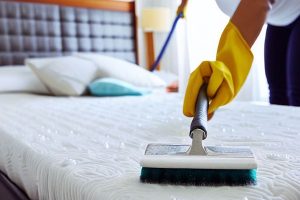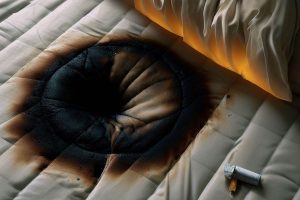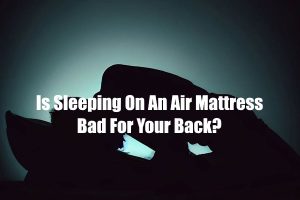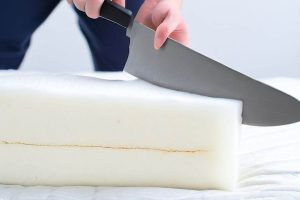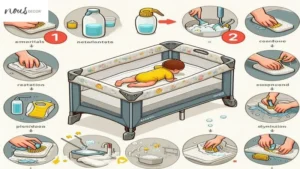I can still remember the feeling of lying in bed, sheets tucked around me, and then feeling a sharp bite on my arm. I had been invaded by bed bugs! But do mattress encasements really provide complete protection against these unwelcome visitors?
In this Nousdecor article, I will explore the answer to the question: “Can Bed Bugs Bite Through Mattress Encasements?”
Through vivid imagery and detailed research, I will guide you through understanding why bed bugs are present in mattresses, what a mattress encasement is versus a protector, if they can penetrate it and how to treat infestations while preventing them from happening again.
Key Takeaways
- Bed bug infestations can occur anywhere and spread quickly through shared living spaces.
- Investing in a mattress cover or encasement can help prevent infestations.
- Mattress encasements completely enclose the mattress on all sides, trapping existing bed bugs inside and preventing them from reaching the person sleeping on the mattress.
- Using both mattress encasements and mattress protectors together provides better protection against bed bugs.

Why Are there Bed Bugs in Your Mattress?
You may be wondering why there are bed bugs in your mattress. Unfortunately, the answer is simple: bed bug infestations can occur anywhere and anytime.
Bed bugs have been known to spread quickly through shared living spaces, such as dormitories and apartments. In addition, since they’re small enough to fit through tiny cracks or gaps in walls or furniture, it doesn’t take long for them to migrate from one location to another.
To help prevent an infestation of bed bugs in your mattress, it’s important to invest in a mattress cover or encasement that will keep pests out.
Moving on…
Mattress Encasement vs Mattress Protector
I’m often asked to compare mattress encasements and mattress protectors. They are both designed to provide protection for mattresses, but they have some differences.
Both mattress encasements and mattress protectors can keep your mattress clean and free of bed bugs. However, an encasement is a more secure option as it zips up completely around the whole mattress, whereas a protector usually just covers the top.
Overall, both options will help you avoid dust mites and other allergens in your bedroom.
Similarities
You’re likely to find similar levels of effectiveness for mattress encasements in protecting against bed bug bites. Both mattress protectors and encasements are made from plastic or a similar material, making them an effective barrier against bed bugs.
Additionally, both fit snugly over mattresses, have zippered closures, provide protection from dust mites and other allergens, and are easy to clean.
The key difference between the two is that mattress encasements completely envelop the entire mattress, including the sides and bottom, while mattress protectors cover only the top surface of the bedding item. However, their main purpose remains the same; to help prevent bed bug bites and provide better sleep hygiene.
Nonetheless, transitioning into a slightly different topic…
Differences
I’m interested in learning more about the differences between mattress encasements and mattress protectors, specifically when it comes to preventing bed bug bites.
Mattress encasements are designed to completely enclose the mattress on all sides. They act as a protective barrier, preventing bed bugs from getting in or out of the mattress. This means that if there are any bed bugs already on the mattress, they will be trapped inside the encasement and unable to reach the person sleeping on the mattress.
On the other hand, a mattress protector is a fitted sheet that goes over the top of your mattress. While it provides some level of protection against spills, stains, and allergens, it may not be as effective in preventing bed bug bites.
It’s important to note that bed bugs are tiny and can squeeze through very small spaces. If there are any gaps or openings in the mattress protector, bed bugs may be able to get through and bite the person sleeping on the mattress.
Mattress Encasement
Mattress encasements can help protect against bed bugs. They are made of water-resistant material, often polyester or cotton coated with permethrin, that covers the entire mattress and box spring. This prevents bedbugs from entering and living in the mattress. Encasements also make extermination easier as they trap existing bugs within the mattress. Plus, they act as a barrier between you and any infestations for added protection.
- Prevent entry
- Trap existing bugs
- Make extermination easier
- Act as a barrier for extra protection.
Encasements provide an effective way to guard against bedbugs.
Now let’s look at how a mattress protector works.

Mattress Protector
A mattress protector is a great way to keep your bed clean and free of germs. It’s usually made of a waterproof material that provides an extra layer between the mattress and sheets, helping to protect against dust mites, liquids, and stains.
Mattress protectors also prevent bed bugs from entering the mattress as they don’t have access to enter through or get trapped in it. To ensure complete bug-proofing, it should be used along with mattress encasements which act as a barrier for bed bugs on the entire mattress surface and all edges around the bed frame.
Together they offer an effective way to get rid of existing bed bugs while preventing new ones from infesting your sleeping space. With this combination, you can rest easy knowing that your sleep environment is safe and comfortable.
Can Bed Bugs Bite Through Mattress Encasements?
You’re probably wondering if bed bugs can bite through mattress encasements. It is possible for bed bugs to penetrate certain kinds of mattress covers, but the vast majority of encasements are designed to prevent this from happening.
Here’s a breakdown of what you should know about memory foam mattresses and mattress protectors:
- Memory foam mattresses should always be covered with a plastic zipper-enclosed encasement that is designed to resist bug infestations.
- Box springs should also be covered with an appropriate plastic zippered cover as well.
- Bed bug infestations in your home can often be treated using special vacuums or steam cleaners, but they may need additional chemical treatments if necessary.
- Regular cleaning and inspection of all bedding materials can help prevent against future bug infestations, so it’s important to keep up on regular maintenance of both your mattress and box spring encasements.
How to Treat Bed Bug Infestations
Identifying and treating bed bug infestations can be daunting, but with proper preparation and execution, it is possible to successfully rid a home of these pests.
To begin, it is important to identify the infested areas.
Contain the area in question by sealing off any openings into other rooms and spaces.
Prepare for extermination by removing any linens or fabric items from the area.
Once ready, exterminate using either chemical or non-chemical methods depending on preference.
After treatment, monitor for signs of remaining bugs and follow up as needed until the infestation has been completely eradicated.
Identify the Infested Areas
It’s important to determine where bed bugs have infested in order to effectively treat the area. The most common areas for bed bugs infestations are mattresses, mattress pads, and box springs. To identify these areas, inspect regularly with a bug protector or fitted sheet over the mattress and box spring.
Here’s a list of what to look for:
- Bites on your body
- Blood stains and dark spots
- Shed exoskeletons from Cimicidae family
- Live adult bed bugs or eggs
Identifying the source of an infestation is key to properly containing the area so that other rooms don’t become affected by the bed bug problem.
Contain the Area
Once you’ve identified the area of infestation, it’s time to contain it so that the problem doesn’t spread. Bed bugs can not bite through mattress encasements, making them an essential part of integrated pest management when dealing with bed bug infestations.
Mattress encasements prevent bed bugs from getting in and out of a mattress while also protecting the mattress itself.
Adding a mattress topper inside the encasement can provide extra protection against any accidental bites. A properly sealed encasement can keep the bed bug problem contained and stop them from spreading across other areas in your home.
With proper containment measures in place, it’s time to move onto preparation for treatment.

Preparation
Now it’s time to prepare for treatment. To contain bedbugs, mattress encasements are essential and should be installed prior to extermination. Here is a 4-step preparation guide:
- Dispose of the mattress in the dumpster outside (see disposing mattress in dumpster).
- Use flea eradication with mattress spray along all seams and edges.
- Sleep while mattress expands within the encasement.
- Refer to an adjustable base mattress compatibility guide for full coverage.
With preparations complete, it’s time to move on to the next step in tackling bedbugs…
Extermination
Exterminating bedbugs can be a difficult process, but with the right tools it doesn’t have to be. Cribs and other sleeping areas should be encased in mattress encasements to reduce the chances of an infestation.
If you suspect that bedbugs have already made their way inside your mattress, it’s important to act quickly and call in a professional exterminator for help.
Mosquitoes may also find their way into your Dreamcloud mattress if you don’t take steps to protect it from pests (see where can i try Dreamcloud mattress).
Flipping a Tempurpedic mattress every so often is one way to keep mosquitoes out (see flipping Tempurpedic mattress advice), while following a mattress selection guide for optimal sleep can help ensure that your sleeping environment is pest-free as well.
Taking these steps will make extermination easier and more efficient when needed, allowing you to move confidently onto monitoring and follow up.
Monitor and Follow up
Once the extermination process is complete, it’s important to stay vigilant and monitor for any signs of bedbugs or pests. Here are four steps you can take to ensure that your mattress remains bug-free:
- Inspect: Regularly check around the edges of your mattress encasement, where bed bugs may be able to bite through, for any signs of infestation.
- Clean: Clean all nearby furniture and floors with a vacuum cleaner to remove any lingering pests or eggs.
- Try Out Mattresses: Experiment with different types of mattresses such as DreamCloud, which can help eliminate bed bug problems in the long run.
- Dispose Properly: Make sure to dispose of mattresses properly by either donating them or incinerating them if necessary (see can mattresses be incinerated).
Preventing Bed Bugs From Infesting Your Mattress
I’m concerned about preventing bed bugs from infesting my mattress, so I take all the necessary precautions.
To start, I keep my home clean and free of clutter as much as possible. This helps to discourage bed bugs from settling in and reproducing.
Additionally, I use a fine mattress encasement or protector that is specifically designed to protect against bed bug bites.
Taking these steps ensures that my mattress remains safe from infestation.
Keep Your Home Clean and Free of Clutter
You need to keep your home clean and free of clutter in order to prevent bed bug infestations. To do this, make sure to:
- Vacuum furniture, carpets, and mattresses regularly.
- Wash linens and blankets weekly in hot water.
- Remove all clutter from around the bed area.
- Clean up any food or drink spills immediately.
By following these simple steps, you can help ensure that your home remains bug-free.
Furthermore, using a fine mattress encasement or protector can further protect against potential infestations and provide an extra layer of protection for your sleeping space.

Use a Fine Mattress Encasement or Protector
Using a fine mattress encasement or protector can provide an extra layer of protection against potential infestations and help keep your home free from pests.
Encasements fit tightly over the entire mattress, like a fitted sheet, to prevent bed bugs from getting inside. They also create a barrier that prevents bed bugs from biting through the fabric. Plus, they’re relatively inexpensive and easy to install.
To ensure you get maximum protection, make sure to buy an encasement or protector that is specifically designed for mattresses and not just any type of fabric cover. Additionally, check that it’s made with high-quality materials such as microfiber or polyester so it won’t tear easily.
Frequently Asked Questions
Conclusion
Wrapping up, mattress encasements provide an effective layer of protection against bed bugs and their bites.
These encasements are strong enough to prevent bed bugs from entering or exiting the mattress, yet they’re still breathable enough for a comfortable night’s sleep.
Still, it’s important to take preventive measures like frequent vacuuming and laundering of bedding if you want to keep these pests at bay.
With proper prevention and treatment methods in place, you can rest assured that your mattress will remain free of bed bugs!

